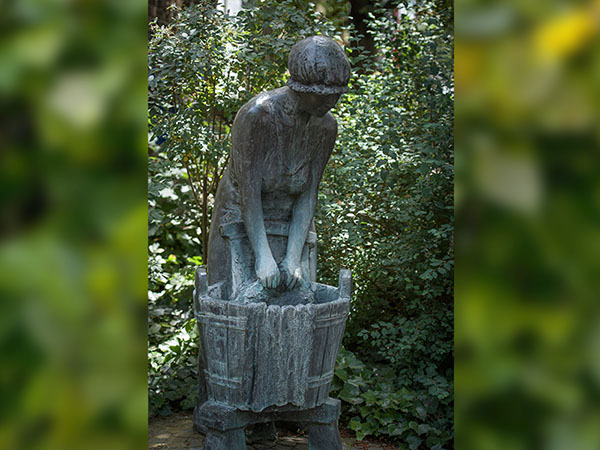
HISTORICAL INFORMATION ON THE WASHERWOMEN'S FOUNTAIN
On this page you will find further information about the Wäscherinnenbrunnen from the Denkmal- und Geschichtsverein Bonn-Rechtsrheinisch e.V. (Monument and History Society Bonn-Rhine).

Washerwomen's Fountain
On the sunny side of Bonn, in Beuel, the trade of the Beuel laundries had been established for centuries. A large part of the laundry from the surrounding towns, including Cologne, was washed here.
In 1824, some women laundresses decided to break up the male domination of the carnival. On the Thursday before the great days, when a large part of the men of Beuel delivered the freshly washed laundry to Cologne by ship, the women joined together to form a ladies' committee (today: Altes Beueler Damenkomitee von 1824 e. V.) and fought the first battle against curmudgeonliness and muckertum. The ladies of Beuel have been doing it pretty hard since that day. This is also evidenced by a stone sculpture, the "nagging washerwoman" (Brückenweibchen), which was placed on the pier of the old Rhine bridge in 1898 to stand up to the bridge man there.
The stone sculpture was salvaged from the ruins of the destroyed Rhine bridge in 1945, erected on the banks of the Rhine for the 125th anniversary of the Beueler Weiberfastnacht in 1949 and ceremoniously unveiled on 25 February 1949 by the Cologne District President Wilhelm Warsch. The inscription on the monument reads: "De Welt es e Lake, dat selvs de Beueler net wäsche können".
In the course of reconstruction work in the area of the bridge, the sculpture was attached to the new flood protection wall near the passenger ferry dock in 2006. The laundresses only really had a bad reputation because of the jecke hustle and bustle on Women's Carnival. The rest of the time, they were as quiet as a lamb.
Beueler Washer Princess
Since 1958, the laundry princess has been proclaimed from the 16 ladies' committees from all parts of Beuel, together with the head maid. In the beginning, the laundry princesses were exclusively provided by the laundries; as this became more and more difficult, the ladies' committees took over this task year after year. The team of the Washer Princess consists of two washerwomen, the adjutants provided by the Beueler Stadtsoldaten-Corps, the head maid and the ladies' committee from which the princess comes. The first Washer Princess in 1958 was Maria Balzer. Since then, "Her Loveliness, the Washer Princess" has helped to storm Beuel's town hall with the head maid and the ladies' committee.
There are plenty of princes and princesses in carnival, but the Wäscherprinzessin only exists in Beuel. She is unique in Germany's carnival regions. Incidentally, she was invented by a Westphalian: Franz Brock, the city director of Beuel at the time.
In addition to the Ladies' Committee, the Beuel City Soldiers, the protective force of the Washer Princess, are indispensable for the Weiberfastnacht. Two of their city soldiers, the so-called Bützoffiziere, have been part of the official delegation of the Beueler Weiberfastnacht for years.
Today, in front of the Beuel Local History Museum, the Laundresses' Fountain, designed by Ernemann Sander, stands in honour of the laundresses. The Beuel Museum of Local History is the first local history museum in the Bonn area. It was opened in 1986 on private initiative in the oldest half-timbered house in Beuel. This museum presents the entire historical development on Beuel soil. The early trades of fishing, shipping and laundry in Beuel are also described and visitors gain an insight into life, work and living at the turn of the century.
Source: de-academic
